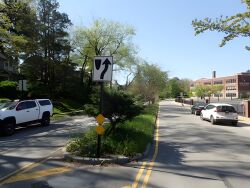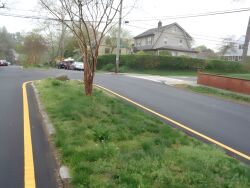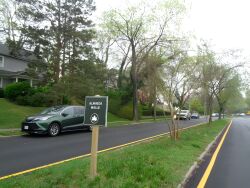Alameda Malls
Alameda Malls
The Alameda Malls run down the center of Alameda Avenue from Northern Boulevard to 247th Street. The words "alameda," "avenue," and "mall" are all names for similar types of street design, but each has a separate historical development.
In Spanish, alamo means poplar tree, and an alameda is literally a street lined with poplars (Liriodendron). While the first alamedas were planted appropriately with poplars, subsequent promenades were planted with other types of trees, but the name "alameda" had already come into general usage. Alamedas were developed in Spain beginning about the 16th century. They were created in areas which were previously too marginal to develop; the Alameda de Hercules in Seville was built in a place once named Lagoon of the Plague for the foul, disease-breeding water that stagnated there before it was finally drained. Other alamedas were built along the outer edge of city walls. In general, they were designed to improve the aesthetic quality of their cities while providing a place for commerce and leisurely recreation.
Avenues, on the other hand, developed primarily in France as tree-lined roads leading from the countryside to the city gate, or other important places like the chateau of an aristocrat. As cities began to grow more quickly, abandoning their city walls and pushing out into the countryside, the avenue became a model for the design of urban streets. Important streets that served to connect suburbs or new city neighborhoods came to be planted with evenly spaced trees. The meaning of the word "avenue" has eroded over time, and is now often used in America to designate streets in a grid system that run in the same direction. Thus, in Manhattan, the avenues are the streets that run south to north, rather than being tree-lined streets.
The first malls were built in Italy and France and soon spread to England. They were playing fields for a game called pall mall. The object of the game was to use a mallet to hit a wooden ball through an iron ring located at the other end of the green. The playing fields were long, narrow strips of grass, set off between streets. They were somewhat similar to bowling greens, such as the one in downtown Manhattan before it was landscaped. Fences around the malls protected passersby from stray balls. Generally located near the city's military quarters, the malls were often used for parades. They also became popular as strolling promenades, and soon malls were being built for the enjoyment of pedestrians without accommodating the sport. In the United States, malls diverged into two different forms: monumental pedestrian axes, and grassy or landscaped areas set between lanes of traffic. The Mall in Washington, D.C., which leads to the Capitol, is an example of the former. The Alameda Malls are an example of the latter. The pedestrian paths gradually disappeared, especially as traffic volumes grew, but the mall design was retained as a landscaping technique.
The word "mall" is now most strongly associated with a third architectural form: large enclosed shopping centers. Beginning as a hybrid between shopping arcades, which were popular in the 19th century, and the landscaped pedestrian promenades, the first enclosed shopping malls were usually oriented around a central walkway that included indoor trees, reminiscent of previous landscaped outdoor promenades.
The Alameda Malls, as with many others, were used by housing developers to introduce more landscaping into the neighborhood and give it a quiet rustic look, generally making it more attractive. The malls are today planted with a variety of trees and shrubs, including Kwanzan cherry (Prunus serrulata 'Kwanzan'), Callery pears (Pyrus calleryana), and Sycamore maples (Acer pseudoplatanus). Perhaps most notable are the large shading Pin oaks (Quercus palustris). There are stone and paver detailings around the bases of many of the trees, and groups of large stones mark the corners with the Douglaston Parkway, giving the Alameda Malls more definition and helping to shelter the quiet residential streets from the traffic.
Check out your park's Vital Signs
Clean & Safe
Green & Resilient
Empowered & Engaged Users
Share your feedback or learn more about how this park is part of a
Vital Park System



